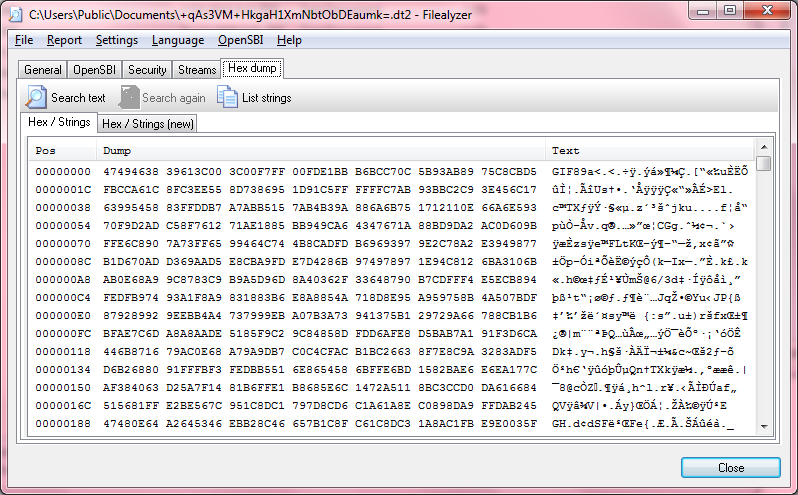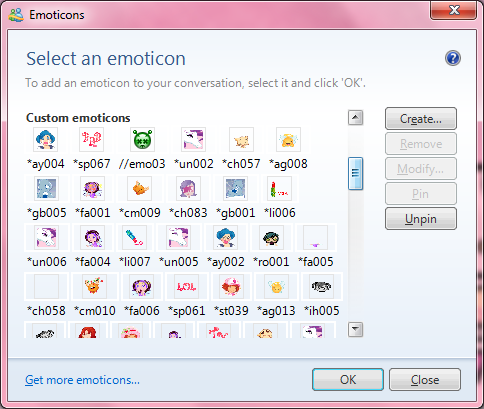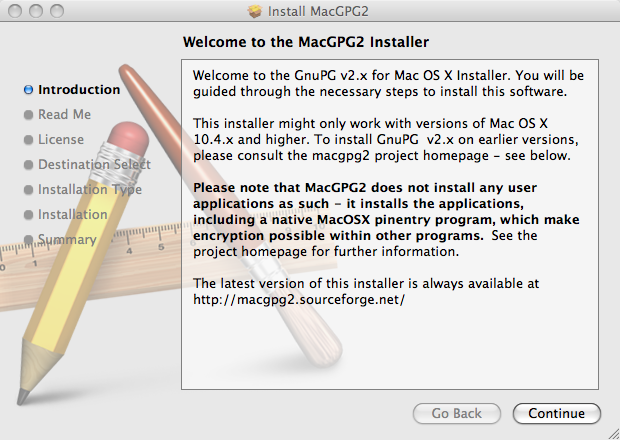Files for Windows Live Messenger Custom Emoticons
In trying to determine how to copy Windows Live Messenger version 2009
emoticon files from one system to another, I found a
C:\Users\acctname\AppData\Local\Microsoft\Messenger\user@example.com\ObjectStore\CustomEmoticons
directory on a Windows 7 system. For the directory path
acctname is the
particular Windows account. The email
address used for logging into Windows Live Messenger would appear in place
of
user@example.com. The equivalent directory on the Windows XP
system from which I was going to copy the custom icons was
\Documents and Settings\acctname\Local Settings\Application Data\Microsoft\Messenger\user@example.com\ObjectStore\CustomEmoticons.
The directory contained .dt2 and .id2 files.
When I checked .dt2 files with
FileAlyzer, I found that they were actually
GIF files. Most were
GIF89a files, but some were GIF87a files as is revealed by the first 6
bytes in the files. GIF89a files have 47 49 46 38 39 61 as
the first six bytes in the files while GIF87a files have
47 49 46 38 37 61 as the first six bytes. If you change the
extension on a file from .dt2 to .gif, you can view the file with an
image viewing program.

There is a .dt2 and .id2 file for each emoticon with names similar
to the example shown below.
ZysU6LltaOP0MVYOBvV4YcbnHr4=.dt2
ZysU6LltaOP0MVYOBvV4YcbnHr4=.id2
These are associated with the emoticons you see in the Custom emoticons
section when you select an emoticon within Windows Live Messenger.

I was able to transfer all of the custom icons for Windows Live Messenger
from the Windows XP system to the Windows 7 system, by copying all the
files in the CustomIcons folder on the Windows XP system to
that folder on the Windows 7 system. Where the files already exist, you can
choose to skip or copy over those files.
Note: if you have Windows Live Messenger open on the destination system
at the time you copy the files to it, you will need to close all Windows
Live Messenger windows and close the program and then reopen it to see
the custom icons you copied.
References:
-
GIF
Wikipedia, the free encyclopedia
-
Decrypting Messenger Id2 files
Date: July 2, 2007
Fanatic Live
[/network/chat/live_messenger]
permanent link
Mac GNU Privacy Guard 2.x
A version of
GNU
Privacy Guard is available for
Mac OS X
systems from
Mac GNU
Privacy Guard. A .zip file,
MacGPG2-2.0.14RC2.zip, can be downloaded from
Mac GNU Privacy Guard v2.x Files.
To install the software, once you've downloaded it, unzip
the contents of the zip file, which you can do from a shell
prompt with the unzip command. Then use the
Finder to locate the .mpkg file that was extracted
from the .zip file. Double-click on it to start the MacGPG2
Installer.

Click on Continue to continue with the installation.
The next step will be to view the Read Me
information, followed by the display of the GNU General Public
License Version 3, which covers the use of the software.
After agreeing to the license, you will be informed of the
amount of space that will be used by the software, which is
21.6 MB for version 2.0.14RC2. When you proceed with the
installation, the gpg executable will be installed in
/usr/local/bin.
You can see other files installed during the installation
with lsbom -fls
/Library/Receipts/macgpg2.pkg/Contents/Archive.bom.
$ lsbom -fls /Library/Receipts/macgpg2.pkg/Contents/Archive.bom
./Applications/start-gpg-agent.app/Contents/Info.plist
./Applications/start-gpg-agent.app/Contents/MacOS/applet
./Applications/start-gpg-agent.app/Contents/PkgInfo
./Applications/start-gpg-agent.app/Contents/Resources/._applet.icns
./Applications/start-gpg-agent.app/Contents/Resources/Scripts/._main
.scpt
./Applications/start-gpg-agent.app/Contents/Resources/Scripts/main.s
cpt
./Applications/start-gpg-agent.app/Contents/Resources/applet.icns
./Applications/start-gpg-agent.app/Contents/Resources/applet.rsrc
./Applications/start-gpg-agent.app/Contents/Resources/description.rt
fd/TXT.rtf
./Library/LaunchAgents/com.sourceforge.macgpg2.gpg-agent.plist
./private/etc/paths.d/MacGPG2
./usr/local/sbin/MacGPG2-login.sh
./usr/local/sbin/MacGPG2-logout.sh
Your keyrings, such as
pubring.gpg, will be installed in
/Users/acctname/.gnupg/. where
acctname represents the particular account
you are using. If you have keyrings already on another system,
you can copy those keyrings to that location. I.e., you can
copy pubring.gpg, secring.gpg, and
trustdb.gpg from the other system. You can see
what keys are in your public keyring with gpg
--list-keys.
References:
-
GNU Privacy Guard
Wikipedia, the
free encyclopedia
-
Mac GNU Privacy Guard
SourceForge
-
Uninstall applications installed from packages
Date: January 11, 2010
By:
oblahdioblidaa
Mac OS X Hints
[/os/os-x/software/security]
permanent link
![]()
![]()


